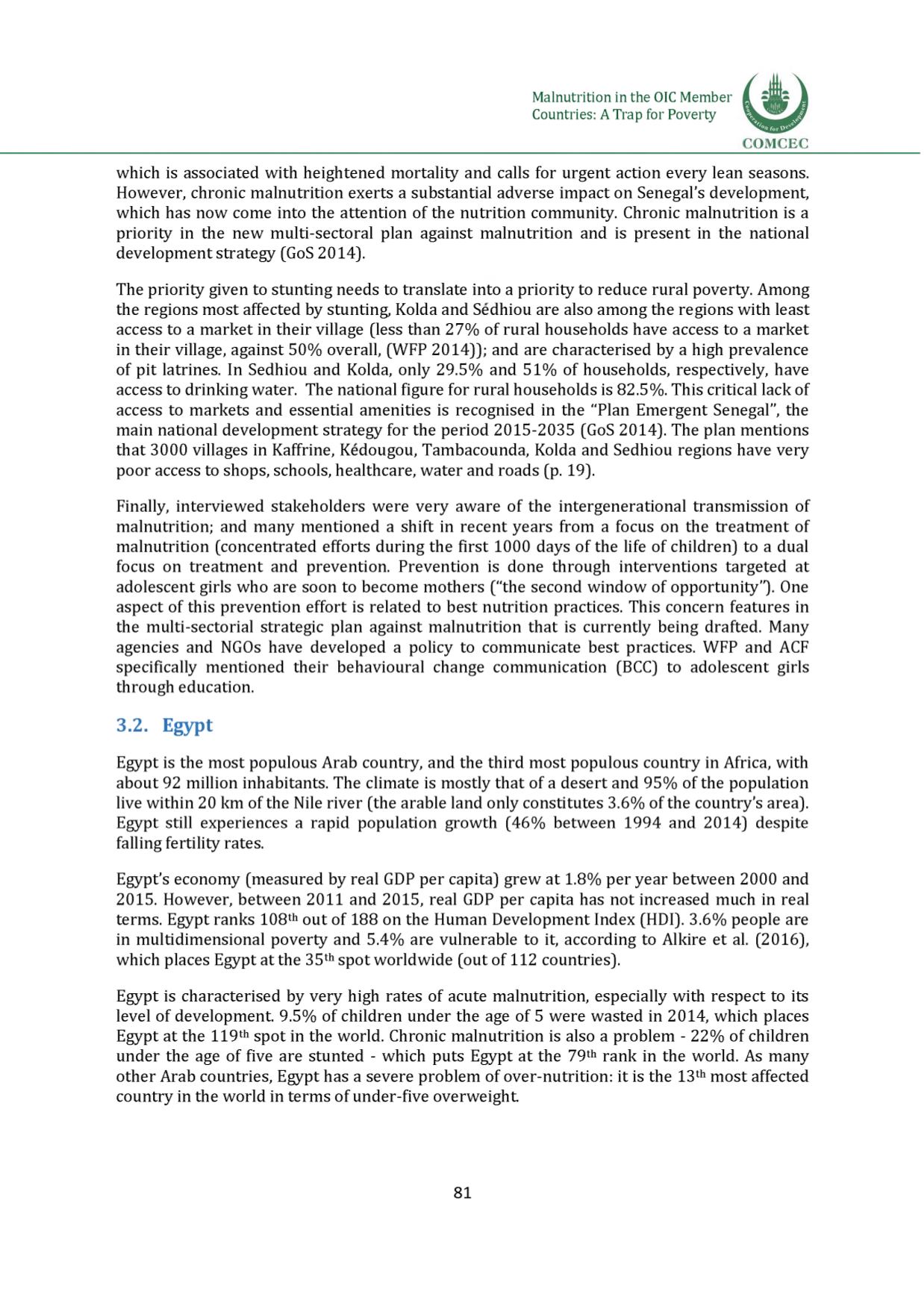

Malnutrition in the OIC Member
Countries: A Trap for Poverty
which is associated with heightened mortality and calls for urgent action every lean seasons.
However, chronic malnutrition exerts a substantial adverse impact on Senegal's development,
which has now come into the attention of the nutrition community. Chronic malnutrition is a
priority in the new multi-sectoral plan against malnutrition and is present in the national
development strategy (GoS 2014).
The priority given to stunting needs to translate into a priority to reduce rural poverty. Among
the regions most affected by stunting, Kolda and Sedhiou are also among the regions with least
access to a market in their village (less than 27% of rural households have access to a market
in their village, against 50% overall, (WFP 2014)); and are characterised by a high prevalence
of pit latrines. In Sedhiou and Kolda, only 29.5% and 51% of households, respectively, have
access to drinking water. The national figure for rural households is 82.5%. This critical lack of
access to markets and essential amenities is recognised in the “Plan Emergent Senegal”, the
main national development strategy for the period 2015-2035 (GoS 2014). The plan mentions
that 3000 villages in Kaffrine, Kedougou, Tambacounda, Kolda and Sedhiou regions have very
poor access to shops, schools, healthcare, water and roads (p. 19).
Finally, interviewed stakeholders were very aware of the intergenerational transmission of
malnutrition; and many mentioned a shift in recent years from a focus on the treatment of
malnutrition (concentrated efforts during the first
1 0 0 0
days of the life of children) to a dual
focus on treatment and prevention. Prevention is done through interventions targeted at
adolescent girls who are soon to become mothers (“the second window of opportunity”). One
aspect of this prevention effort is related to best nutrition practices. This concern features in
the multi-sectorial strategic plan against malnutrition that is currently being drafted. Many
agencies and NGOs have developed a policy to communicate best practices. WFP and ACF
specifically mentioned their behavioural change communication (BCC) to adolescent girls
through education.
3.2. Egypt
Egypt is the most populous Arab country, and the third most populous country in Africa, with
about 92 million inhabitants. The climate is mostly that of a desert and 95% of the population
live within 20 km of the Nile river (the arable land only constitutes 3.6% of the country's area).
Egypt still experiences a rapid population growth (46% between 1994 and 2014) despite
falling fertility rates.
Egypt's economy (measured by real GDP per capita) grew at 1.8% per year between 2000 and
2015. However, between 2011 and 2015, real GDP per capita has not increased much in real
terms. Egypt ranks 108thout of 188 on the Human Development Index (HDI). 3.6% people are
in multidimensional poverty and 5.4% are vulnerable to it, according to Alkire et al. (2016),
which places Egypt at the 35thspot worldwide (out of 112 countries).
Egypt is characterised by very high rates of acute malnutrition, especially with respect to its
level of development. 9.5% of children under the age of 5 were wasted in 2014, which places
Egypt at the 119th spot in the world. Chronic malnutrition is also a problem - 22% of children
under the age of five are stunted - which puts Egypt at the 79th rank in the world. As many
other Arab countries, Egypt has a severe problem of over-nutrition: it is the 13thmost affected
country in the world in terms of under-five overweight.
81
















